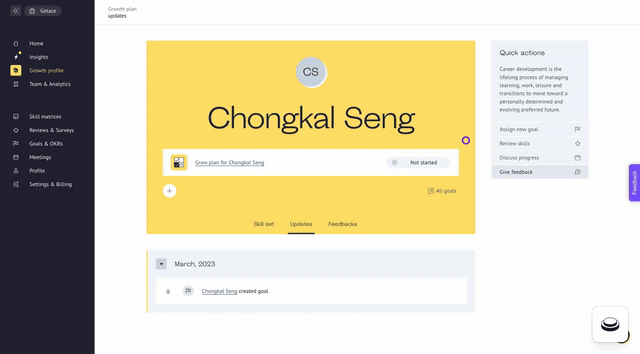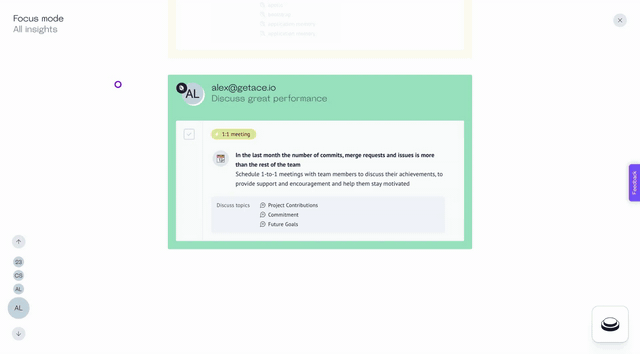As one of the most valuable assets to any organization, software developers require constant professional skill development to stay ahead in a rapidly evolving industry.
This is why professional development plan (PDP) is the best tool in any manager’s toolbox, when it comes to hiring and retaining top tech talent.
In this blog, we’ll discuss what is a professional development plan and provide you with a step-by-step guide on how to create a professional development plan and hack this process with the help of Ace AI.
Engineering management trends
In his 2021 keynote speech at the HR Technology Conference, Josh Bersin, the president and founder of a leading industry research and advisory firm in enterprise learning and talent management, highlighted the following trends in management:
Transitioning from standard HR practices towards the new employee-based approach. In today’s corporate world, employee experience takes over and should be placed at the center of everything a manager does. So, companies tend to invest in the professional development of their employees and growing their skills, rather than hiring new talent.
Learning in the flow of work. Modern employees are doing a lot of learning in the workplace, and it’s in the company’s interest to allow their knowledge workers the opportunity to stay on top of the most recent industry trends, tools, and methods. Plus, the learning process starts being a part of the workflow.
Skills development platforms are the “next big thing”. The services which allow managers to accelerate and monitor their employees’ professional development are becoming more and more important. So, it’s only natural that skills engines, skills inference, and talent intelligence systems are taking over.
These trends further emphasize the importance of a scalable, robust, and thorough professional development routine. It’s not just in the company’s interest to provide their knowledge workers with growing opportunities, but it’s also their responsibility. This is where professional development plans come in.
What is a professional development plan?
To build a successful product, software developers must stay up-to-date with industry trends. As such, engineering managers should invest in their developers' professional development. This includes providing opportunities for skill enhancement, training, and exposure to new technologies.
Failing to do so can result in a high turnover rate, as developers seek out companies that prioritize their professional growth. Ultimately, investing in your software developers' professional development is not only beneficial to them but to the success of your company as well.
Professional development plan as a tool
This is where a professional development plan, or PDP, comes in handy. A professional development plan is a tool that helps managers support their employees' growth and development. It should include clear goals, timelines, and actionable steps to achieve those goals.
The plan should also identify any skills gaps that need to be addressed and outline the resources needed to bridge those gaps.
Additionally, a professional development plan should take into account the individual's interests, career aspirations, and the company's overall goals to create a personalized roadmap for growth.
By creating a professional development plan, managers can ensure that their software developers receive the necessary support to stay up-to-date with the latest trends and technologies, leading to a more skilled and engaged workforce.
What should be included in a professional development plan?
A properly implemented system of PDP will allow your company to:
FILL THE TEAM'S SKILL GAPS AND INCREASE DEVELOPER PRODUCTIVITY
Investing in the professional development of your software developers can unlock the potential of each team member, ultimately increasing overall team performance and driving your company to extraordinary results. A high-quality Professional Development Plan (PDP) can help prevent major skill gaps in knowledge workers by aligning individual employee goals with the current goals and priorities of the company at large. At its core, a PDP should reflect the strategic vision provided by executives and managers. By creating a personalized roadmap for growth, you can ensure that each team member is equipped with the necessary skills to contribute to the company's success.
MAKE PROMOTION DECISIONS TRANSPARENT
A Professional Development Plan (PDP) is an essential tool for not only enhancing the skills and knowledge of your software developers but also for creating a clear path to career advancement within your organization. By outlining the necessary steps and skill sets required for promotion, a PDP provides employees with a sense of direction and motivation for their professional development. Everyone knows what they need to do and what skills to develop to get promoted.
INCREASE EMPLOYEE RETENTION AND LOYALTY
Lack of professional growth opportunities is the number one reason employees leave a company. Fortunately, implementing a Professional Development Plan (PDP) can help increase retention rates by providing employees with clear career advancement paths and growth opportunities.
By creating a transparent and supportive culture that includes clearly outlined professional development roadmaps and aligning employee goals with the company's objectives, you can improve employee satisfaction and foster loyalty. A PDP enables managers to identify and address skill gaps in their team, providing the necessary support for employees to reach their full potential. As a result, employees are more likely to feel valued and invested in the success of the company, leading to increased retention rates and a more motivated workforce.
PROTECT DEVELOPERS FROM BURNOUT
A well-defined Professional Development Plan (PDP) not only supports the growth of your software developers but can also help protect them from burnout. Uncertainty about one's career trajectory can contribute to stress and anxiety, ultimately leading to burnout. By providing a clear roadmap for career advancement, a PDP can help alleviate this stress and foster a sense of purpose and direction in employees. Additionally, a PDP can help developers better manage their workloads by identifying skill gaps and areas for improvement, allowing for a more efficient use of time and resources.
Steps to build PDP
In this part, we’ll provide you with the main steps of creating a Professional Development Plan for your tech team. Also, you will find out how you can hack this process with the use of AI.
STEP #1. IDENTIFY CAREER PATH LEVEL
At this stage, a manager assesses an employee’s skills, finds potential skill gaps, and identifies their career path level (or a grade). To do this, you should hold a skills review for the whole team and then analyze the review report.
To identify career path levels easily and fast, we recommend using AI tools that can do it for you.
Ace AI uses Git data to define the career path level of a software engineer. See how it works in practice:

Ace AI identifies career level based on Git data
STEP #2. CREATE A DEVELOPMENT GOAL
After a manager identified skill gaps and the grade of a developer, a development goal should be set.
Use Ace AI to create personalized development goals for the whole team based on identified skill gaps in Git. Ace AI will automatically provide you with development goals after you connect Git.

Connect Git and get a development goal in Ace AI
STEP #3. ADD INITIATIVES (TASKS) TO A GROWTH PLAN
In order to reach the development goal, a manager creates a growth plan and adds learning activities and working tasks to develop focus skills.
To save time on the search for personalized learning activities for each developer, you can use Ace AI which gives personalized recommendations on mentors and learning activities such as courses, books, etc. based on their skill gaps.
See how Ace AI recommendations work in practice:

Personalized recommendations in Ace AI
STEP #4. MONITOR PROGRESS
In order to make the process of professional development effective and implement continuous learning in your tech team’s workflow, an engineering manager should hold regular 1-on-1 meetings with team members to track the progress and adjust their growth plans if necessary, as well as provide feedback on their skill development.
To help you with that, Ace AI writes automatic feedback for specific skills for you to save time.

Automatic feedback for skills in Ace AI
Also, Ace AI builds automatic agenda for your 1-on-1 meeting to discuss growth plan progress based on developer updates from Git and growth plan initiatives.

Automatic agenda for 1 on 1 in Ace AI
Key ideas
- As one of the most valuable assets to any organization, software developers require constant professional skill development to stay ahead in a rapidly evolving industry.
- A professional development plan is the best tool to stimulate and provide guidance for your employees’ professional growth.
- The stages of an effective development plan are: identifying career level, creating a development goal, adding activities to a growth plan, and regular monitoring.
- Engineering managers can hack the process of their team’s professional skill development with tools such Ace AI. It automates the process of creating professional development plans with personalized insights and recommendations.



Top comments (0)